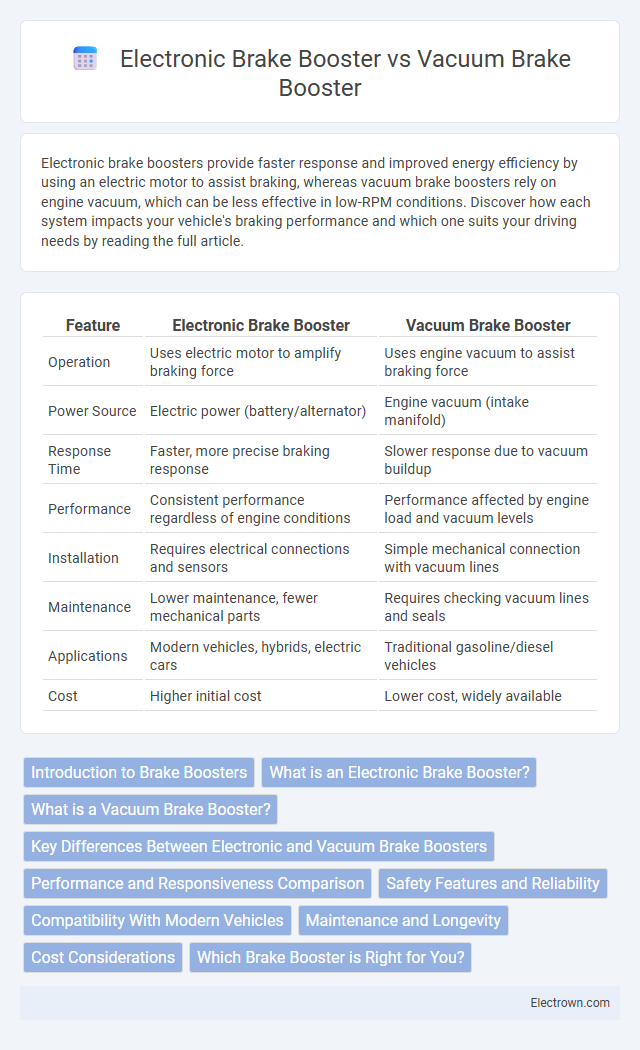Electronic brake boosters provide faster response and improved energy efficiency by using an electric motor to assist braking, whereas vacuum brake boosters rely on engine vacuum, which can be less effective in low-RPM conditions. Discover how each system impacts your vehicle's braking performance and which one suits your driving needs by reading the full article.
Table of Comparison
| Feature | Electronic Brake Booster | Vacuum Brake Booster |
|---|---|---|
| Operation | Uses electric motor to amplify braking force | Uses engine vacuum to assist braking force |
| Power Source | Electric power (battery/alternator) | Engine vacuum (intake manifold) |
| Response Time | Faster, more precise braking response | Slower response due to vacuum buildup |
| Performance | Consistent performance regardless of engine conditions | Performance affected by engine load and vacuum levels |
| Installation | Requires electrical connections and sensors | Simple mechanical connection with vacuum lines |
| Maintenance | Lower maintenance, fewer mechanical parts | Requires checking vacuum lines and seals |
| Applications | Modern vehicles, hybrids, electric cars | Traditional gasoline/diesel vehicles |
| Cost | Higher initial cost | Lower cost, widely available |
Introduction to Brake Boosters
Brake boosters enhance braking performance by amplifying the driver's pedal force to the master cylinder. Electronic brake boosters use electric motors and sensors for precise and responsive assistance, improving energy efficiency and compatibility with advanced driver-assistance systems (ADAS). Vacuum brake boosters rely on engine vacuum to create pressure differentials, offering simplicity and reliability but limited performance in low-vacuum conditions.
What is an Electronic Brake Booster?
An electronic brake booster is a modern braking system component that uses an electric motor to amplify brake pedal force, enhancing braking efficiency and responsiveness compared to traditional vacuum brake boosters. It integrates with advanced driver-assistance systems (ADAS) and electric vehicles, where vacuum sources are limited or unavailable. Your vehicle benefits from faster brake response times and improved energy efficiency through this innovative braking technology.
What is a Vacuum Brake Booster?
A vacuum brake booster is a device that uses engine vacuum to amplify the force applied to the brake pedal, making it easier to stop your vehicle. It operates by creating a pressure differential between the vacuum chamber and atmospheric pressure, which assists in pushing the master cylinder piston. This type of booster is commonly found in traditional vehicles but may struggle in electric or turbocharged engines where vacuum supply is limited.
Key Differences Between Electronic and Vacuum Brake Boosters
Electronic brake boosters use an electric motor to generate brake assist, providing faster response times and improved efficiency compared to traditional vacuum brake boosters, which rely on engine vacuum to amplify brake pedal force. Unlike vacuum boosters that depend on the continuous availability of vacuum pressure, electronic boosters offer consistent performance regardless of engine load or conditions, enhancing braking reliability in modern vehicles, especially hybrids and electric cars. Electronic brake boosters also facilitate advanced driver-assistance systems (ADAS) integration and regenerative braking, features not supported by conventional vacuum brake boosters.
Performance and Responsiveness Comparison
Electronic brake boosters offer superior performance and faster responsiveness compared to vacuum brake boosters due to their use of electric motors that provide consistent and immediate assistance regardless of engine vacuum levels. Vacuum brake boosters rely on engine vacuum, which can vary with engine load and RPM, sometimes causing delayed or inconsistent brake response. The precision and adaptability of electronic brake boosters enhance overall braking efficiency and safety in modern vehicles.
Safety Features and Reliability
Electronic brake boosters provide enhanced safety features through faster response times and adaptive control, improving brake performance under various driving conditions. Vacuum brake boosters rely on engine vacuum, which may reduce reliability during engine failure or high-demand braking situations. You benefit from electronic boosters' consistent reliability and advanced safety mechanisms designed to optimize braking efficiency.
Compatibility With Modern Vehicles
Electronic brake boosters offer superior compatibility with modern vehicles equipped with advanced electronic control systems and hybrid or electric powertrains, providing efficient braking response without relying on engine vacuum. Vacuum brake boosters, traditionally dependent on engine vacuum, may face limitations in electric vehicles and newer models with reduced or no vacuum availability. Your choice between these systems significantly impacts braking performance and integration with the vehicle's electronic architecture.
Maintenance and Longevity
Electronic brake boosters require less frequent maintenance compared to vacuum brake boosters due to the absence of vacuum lines and seals that can wear out or leak. Vacuum brake boosters often need periodic inspection and replacement of vacuum hoses, diaphragms, and check valves to ensure reliable performance. The longevity of electronic brake boosters tends to exceed that of vacuum systems because their electronic components are less susceptible to degradation from engine heat and environmental factors.
Cost Considerations
Electronic brake boosters typically have a higher initial cost compared to vacuum brake boosters due to advanced technology and integrated sensors. Vacuum brake boosters are generally more affordable, with lower manufacturing and replacement expenses, making them cost-effective for budget-conscious vehicle owners. Your choice may depend on balancing upfront investment against potential long-term benefits like improved braking performance and fuel efficiency.
Which Brake Booster is Right for You?
Choosing between an electronic brake booster and a vacuum brake booster depends on your vehicle's performance needs and driving conditions. Electronic brake boosters offer faster response times and consistent braking power, making them ideal for modern vehicles with advanced safety systems and stop-and-go traffic. Vacuum brake boosters, known for their reliability and simplicity, work well for traditional vehicles and drivers prioritizing cost-effectiveness and ease of maintenance.
Electronic brake booster vs Vacuum brake booster Infographic

 electrown.com
electrown.com